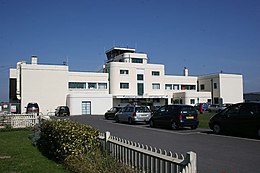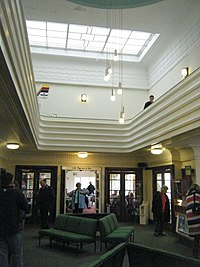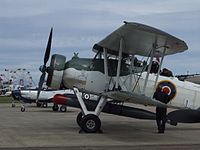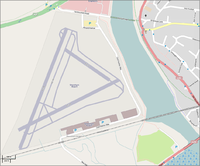Brighton City Airport: Difference between revisions
Created page with "{{Infobox airport |name=Brighton City Airport |county=Sussex |picture=Terminal Building at Shoreham Airport - geograph.org.uk - 573952.jpg |os grid ref=TQ203054 |latitude=50...." |
No edit summary |
||
| (One intermediate revision by the same user not shown) | |||
| Line 33: | Line 33: | ||
==History== | ==History== | ||
[[File:Shoreham (Brighton City) Airport (6659107193).jpg|right|thumb|200px|Interior of the terminal building]] | [[File:Shoreham (Brighton City) Airport (6659107193).jpg|right|thumb|200px|Interior of the terminal building]] | ||
===Foundation=== | ===Foundation=== | ||
The first aviator to fly there was Harold H. Piffard in 1910; a memorial garden celebrates his flight.<ref name=b70 /> The aerodrome was officially opened on 20 June 1911. The first flying school opened in 1913. | The first aviator to fly there was Harold H. Piffard in 1910; a memorial garden celebrates his flight.<ref name=b70 /> The aerodrome was officially opened on 20 June 1911. The first flying school opened in 1913. | ||
| Line 78: | Line 77: | ||
==RAFA Shoreham Airshow== | ==RAFA Shoreham Airshow== | ||
[[File:Fairey Swordfish 2 (6064836688).jpg|thumb| | [[File:Fairey Swordfish 2 (6064836688).jpg|right|thumb|200px|Fairey Swordfish torpedo bomber at 2011 airshow]] | ||
The airport hosted the Royal Air Forces Association Shoreham Airshow for around 25 years. On 22 August 2015, a Hawker Hunter jet fighter taking part in the airshow crashed onto the A27 road just outside Brighton City Airport, killing 11 people, and the show has not been held since.<ref>{{cite news |url=https://www.bbc.co.uk/news/uk-england-34034430 |title=Shoreham air crash death toll 'rises to 11' |work=[[BBC News]]|date=24 August 2015|access-date=21 January 2022}}</ref> | The airport hosted the Royal Air Forces Association Shoreham Airshow for around 25 years. On 22 August 2015, a Hawker Hunter jet fighter taking part in the airshow crashed onto the A27 road just outside Brighton City Airport, killing 11 people, and the show has not been held since.<ref>{{cite news |url=https://www.bbc.co.uk/news/uk-england-34034430 |title=Shoreham air crash death toll 'rises to 11' |work=[[BBC News]]|date=24 August 2015|access-date=21 January 2022}}</ref> | ||
==Facilities== | ==Facilities== | ||
[[File:Shoreham Airport OSM.png|thumb|Brighton City Airport]] | [[File:Shoreham Airport OSM.png|right|thumb|200px|Brighton City Airport]] | ||
There is one terminal building at the airport, together with flight indicator boards announcing all arrivals and departures, a live runway camera and a licensed restaurant called ''The Hummingbird Restaurant and Cafe''. The airport houses Northbrook College's engineering department – a Centre of Vocational Excellence (CoVE) in Aerospace and Aviation. A number of aerospace and aviation and non-aviation commercial businesses have offices and workshops on the airport site and along the perimeter road. The largest operator is Flying Time Aviation, providing integrated commercial pilot training, with a fleet of Diamond Aircraft DA40s and DA42s. | There is one terminal building at the airport, together with flight indicator boards announcing all arrivals and departures, a live runway camera and a licensed restaurant called ''The Hummingbird Restaurant and Cafe''. The airport houses Northbrook College's engineering department – a Centre of Vocational Excellence (CoVE) in Aerospace and Aviation. A number of aerospace and aviation and non-aviation commercial businesses have offices and workshops on the airport site and along the perimeter road. The largest operator is Flying Time Aviation, providing integrated commercial pilot training, with a fleet of Diamond Aircraft DA40s and DA42s. | ||
| Line 93: | Line 91: | ||
==Outside links== | ==Outside links== | ||
{{commons|Shoreham Airport}} | {{commons|Shoreham Airport}} | ||
*[http://www.flybrighton.com/ | *[http://www.flybrighton.com/ Brighton City Airport] | ||
==References== | ==References== | ||
Latest revision as of 23:01, 13 February 2023
| Brighton City Airport | |
 | |
|---|---|
| Code | IATA: ESH, ICAO: EGKA |
| County | Sussex |
| Public | |
| Owner | Brighton City Airport Limited |
| Operator | Cyrrus Holdings Limited |
| Location | TQ203054 50°50’8"N, 0°17’34"W |
| Runway(s) | 3,400 feet (Asphalt) 2,621 feet (Grass) 1,340 feet (Grass) |
| Website | flybrighton.com |
Brighton City Airport (IATA: ESH, ICAO: EGKA), also commonly known as Shoreham Airport, is located by Lancing in Sussex. It has a Civil Aviation Authority Public Use Aerodrome Licence that allows flights for the public transport of passengers or for flying instruction.
Founded in 1910, this is the oldest airport in the United Kingdom and the oldest purpose-built commercial airport in the world still in operation.[1] It is now owned by Brighton City Airport Ltd (BCAL).[2] The 1930s Art Deco terminal building designed by R Stavers Hessell Tiltman is listed grade II*.[3]
The airport is 1 nautical mile west of Shoreham-by-Sea, at Lancing, immediately to the south of the A27 road, between Brighton and Worthing, and immediately to the north of the West Coastway railway line.
History

Foundation
The first aviator to fly there was Harold H. Piffard in 1910; a memorial garden celebrates his flight.[1] The aerodrome was officially opened on 20 June 1911. The first flying school opened in 1913.
First World War
During the First World War the aerodrome was used by the Royal Flying Corps. It was the departure point for some of the earlier flights, using Blériots[4] and BEs, to join the conflict across the Channel.[5]
Inter-war period
The aerodrome became an airport for the adjacent towns of Brighton, Hove and Worthing. It was officially opened on 13 June 1936 under the name Brighton Hove and Worthing Joint Municipal Airport. The new terminal building was built in 1936 and was designed by Stavers Tiltman in the Art Deco style. The terminal building is still in use and was designated a Grade II* listed building in 1984.
In 1937 one of the local flying schools received a contract to train pilots for the Royal Air Force and was known as No. 16 Elementary and Reserve Flying Training School initially using the de Havilland Tiger Moth which were later supplemented by the use of the Hawker Hart and Hind. With the start of the Second First World Warmminent, the training school moved away from Shoreham in August 1939.[6]
Second World War
The airfield started the Second World War in civilian hands until a detachment of Westland Lysanders of 225 Squadron arrived in July 1940 to undertake coastal patrols.[6] With the nearby RAF Tangmere damaged by air raids the Fighter Interception Unit with the Bristol Beaufighter moved to Shoreham although they had problems with the grass runway.[6] In October 1940 422 Flight arrived with the Hawker Hurricane operating as night-fighters. By October 1941 both units had moved away from Shoreham.[6]
The airfield was regularly attacked during July and August 1941 and the next unit to arrive was No 11 Group Target Towing Flight in October 1941.[6] Westland Lysanders were used to tow targets for fighter squadrons to practice air-firing.[6] Lysanders and later the Supermarine Walrus were also based for search and rescue duties.[6] In December 1941 a detachment of Hawker Hurricane fighters from 245 Squadron arrived at Shoreham to support the Tangmere-based squadrons. By August 1941 the fighters had moved on and only the 277 Squadron remained in the search and rescue; the Lysanders were replaced by the Boulton Paul Defiants in May 1942.[6]
In February 1943 the Defiants were replaced by Supermarine Spitfires and in April 1943 the airfield became a practice camp for RAF Regiment gunners in the anti-aircraft role.[6] Lysanders appeared again but this time to tow targets for the regiment's gunners.[6] A gunnery training dome built on the northern perimeter of the airfield is still there.[6]
In April 1944 No. 345 (Free French) Squadron arrived with Spitfires to support the preparations for the Normandy invasion; the squadron was active on D-Day over the beaches and escorting glider formations.[6] No 345 Squadron moved out in August 1944 and 277 Squadron in October 1944 and the airfield went into care and maintenance and was little used for the rest of the war.[6]
The airfield was bombed several times and a Messerschmitt Bf 109 was shot down by ground fire during one such attack, crash-landing near the terminal building.[7]
A B-17 Flying Fortress crash-landed at the airfield after being damaged during a raid on Germany. The consequent damage to the old guardhouse on the north side of the airfield can still be seen.
Post-Second World War
The landing area was entirely grass until a tarmac runway was built in 1981.
In 1949, F G Miles Engineering Ltd moved to Shoreham from Redhill Aerodrome and soon occupied the repaired Municipal Hangar.
Beagle Aircraft Ltd (British Executive & General Aviation Ltd) was formed at Shoreham on 7 October 1960 and design drawings were begun a few weeks later for a new prototype twin-engine light transport aircraft. Built as the Beagle B.206X at Beagle's Rearsby factory near Leicester, this promising new type was completed at Shoreham and first flown by John Nicolson on 15 August 1961. Beagle Aircraft Ltd was nationalised in late 1966 and taken over by the British Motor Corporation but later entered receivership in late 1969 and soon closed down.
In 2006, due to mounting debts the airport was sold by the local authority to a property company on a 150-year lease. It was intended that the airport would provide increasing commercial flight activity for the conurbation on the coast nearby, particularly the city of Brighton & Hove.
Present
The airport is used by privately owned light aeroplanes, flying schools, and for light aircraft and helicopter maintenance and sales. A number of operators provide flying lessons, sight-seeing and pleasure flights, including the experience of flying in two T-6 Harvard Second World War training aircraft.
On 2 May 2014, Brighton City Airport Ltd (BCAL) acquired a lease and took ownership of its operations, which at the time was named Shoreham Airport, taking over from Albemarle.[2] Once the takeover was completed, the airport was officially renamed as Brighton City (Shoreham) Airport.[8]
In August 2019 Cyrrus acquired a 25 year lease from Brighton & Hove City Council to operate the airport[9]
Wild Life Festival
Annually between 2015 and 2017, Wild Life Festival, a live music event developed by Disclosure and Rudimental was held at Brighton City Airport.[10]
RAFA Shoreham Airshow

The airport hosted the Royal Air Forces Association Shoreham Airshow for around 25 years. On 22 August 2015, a Hawker Hunter jet fighter taking part in the airshow crashed onto the A27 road just outside Brighton City Airport, killing 11 people, and the show has not been held since.[11]
Facilities

There is one terminal building at the airport, together with flight indicator boards announcing all arrivals and departures, a live runway camera and a licensed restaurant called The Hummingbird Restaurant and Cafe. The airport houses Northbrook College's engineering department – a Centre of Vocational Excellence (CoVE) in Aerospace and Aviation. A number of aerospace and aviation and non-aviation commercial businesses have offices and workshops on the airport site and along the perimeter road. The largest operator is Flying Time Aviation, providing integrated commercial pilot training, with a fleet of Diamond Aircraft DA40s and DA42s.
The visitor centre features exhibits about the airport's history and area aviation history, a library and archive of related historic materials and guided tours of the airport.
Film appearances
Due to its listed period facilities and art deco main building, Brighton City Airport has been used by film-makers seeking to portray a small town airport, or also for historical reconstructions of airport scenes from the 1930s onwards.
Outside links
| ("Wikimedia Commons" has material about Brighton City Airport) |
References
- ↑ 1.0 1.1 Bloom, Nick. "Sunny Shoreham", Pilot, February 2012, p70
- ↑ 2.0 2.1 "New plan 'safeguards future of Shoreham Airport'". worthingherald.co.uk. http://www.worthingherald.co.uk/news/local/new-plan-safeguards-future-of-shoreham-airport-1-6035934.
- ↑ National Heritage List 1353731: @
- ↑ Royal Flying Corps WW1 Blériot XI reconnaissance monoplane | "Archived Document". http://aircraft-photographs.s3-website-eu-west-1.amazonaws.com/aircraft-ww1-RFC-bleriot-XI-observation-monoplane.html.
- ↑ Bloom, Nick. "Sunny Shoreham", Pilot, February 2012, p71
- ↑ 6.00 6.01 6.02 6.03 6.04 6.05 6.06 6.07 6.08 6.09 6.10 6.11 6.12 Brooks 1996, pp. 123–130
- ↑ Pocock, D A (1995). "The Royal Air Force Regiment; The Formative years to 1946". Journal of the Royal Air Force Historical Society (15): 23. OCLC 21256749.
- ↑ "About Brighton City Airport – Flying With Us – Shoreham". http://flybrighton.com/about-us/.
- ↑ "Cyrrus acquires Brighton City Airport". 28 August 2019. https://www.breakingtravelnews.com/news/article/cyrrus-acquires-brighton-city-airport/.
- ↑ Cooper, Leonie (29 January 2015). "Nas, Mark Ronson, Earl Sweatshirt added to Disclosure and Rudimental's Wild Life festival". NME. http://www.nme.com/news/disclosure/82552#uHU3f1SQkodQ4jjp.99.
- ↑ "Shoreham air crash death toll 'rises to 11'". BBC News. 24 August 2015. https://www.bbc.co.uk/news/uk-england-34034430.
- Brooks, Robin J. (1996). Sussex Airfields in the Second World War. Newbury, Berkshire, England: Countryside Books. ISBN 1-85306-259-6.
- Lake, A (1999). Flying units of the RAF. Shrewsbury: Airlife. ISBN 1-84037-086-6.
